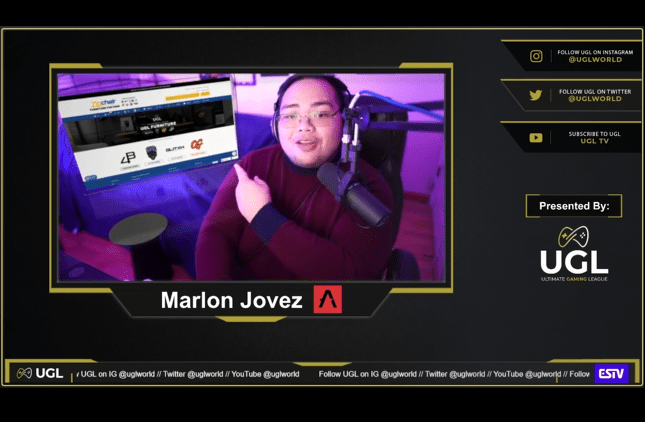How ESTV uses augmented reality to engage streaming viewers

Subscribe to NCS for the latest news, project case studies and product announcements in broadcast technology, creative design and engineering delivered to your inbox.
Much of the content ESTV streams is already virtual — given that it covers esports — but the company quickly realized it needed to enhance the look of when its program creators are on screen, as well.
Augmented reality (AR) was the logical choice, not only because it puts it in line with “big league” broadcasters, but it also brings the look and feel that its audience is used to seeing in the gaming experience alongside program hosts.
“There are so many different content creators around the world. Whether it’s YouTube, Twitch or everybody else, they’re all just streaming and talking and playing games on their consoles or PC,” noted Eric Yoon, CEO and founder of ESTV.
“But if you can embed a couple of unique AR images or provide visibility into the gameplay while maintaining a connection with both the audience and user, that’s where you have the engagement coming from. So it takes you from square one to the 10th floor,” said Yoon.

Ultimate Gaming League (UGL) show on ESTV displaying augmented reality logo.
This is especially true in an online world like YouTube where users scroll through thumbnails of dozens upon dozens of content options. In these cases, having AR elements pop up in the previews can really help the content stand out, grab attention, and make it more likely that a viewer will explore your feed.
Yoon notes that ESTV hosts are from around the world and often broadcast from living and bedrooms and therefore don’t have access to full studio setups.
Arti’s cloud-based AR platform provides ESTV the flexibility and tools they need to enhance their storytelling with AR, just like traditional sports broadcasters.
Because Arti’s AR solution runs on consumer-grade smartphones, tablets and laptops and doesn’t require any specialized camera hardware or tracking system, it was the right choice for enabling ESTV hosts to bring AR elements into their content.
Arti also doesn’t require a team of people back in a control room or production truck, so it’s ideal for solo video content creators. A presenter can pull up a full augmented reality experience as they need it and directly from devices they have on-hand.
This capability is key for giving ESTV’s program creators the power to illustrate what they are talking about by showing it on screen instead of just describing it.
“Traditional linear TV represents a one-way experience — just basically shooting content for a viewer,” said Yoon. “If you fail to interact with your user and a viewer, you’re not going to get to the next level.”
The world of esports is, like traditional sports, heavily data-driven, so displaying stats in the form of AR charts and graphs is a great opportunity for hosts to show number breakdowns rather than reading out long lists of numbers. All of these can be built in a matter of minutes with Arti, thanks to built-in templating tools.
“It’s very easy to use and only requires a mobile app,” noted Yoon. The company has worked with Arti to deploy the technology to hosts in multiple locations and the short learning curve makes it easier for them to dive in and get started, particularly given that many of them are already savvy with apps and navigating 3D environments.

An ESTV host gestures to a sponsors’s website displayed in AR.
Given that most program hosts only have single-camera setups with minimal professional grade lighting, it was also important for the network to find a way to display screen content alongside hosts.
The solution? Floating AR “screens” created with Arti that appear over the host’s shoulder and provide them the opportunity to discuss specific players, characters or other gameplay elements while still remaining on screen and just gesturing to the virtual elements.
Similarly, Arti and augmented reality are also starting to play a key role in revenue generation, allowing program hosts to pull up website screenshots, product photos and sponsor logos, all while remaining on screen to boost the personal connection with viewers, making host-read sponsorships on podcasts and similar content so effective.
Looking toward the future, ESTV and Arti are already exploring ways to enhance “first person” events such as drone racing and cycling events that blend real and virtual competitors with AR.
Arti also sees its technology as a way for established sports operations to enhance their multiplatform content, particularly on social media.
“The reality is that you’re increasingly seeing broadcasters and sports operations filling their social feeds and YouTube channels with unique video content produced by individuals that are acting more like content creators than traditional broadcast,” said Avner Vilan, co-founder and CEO of Arti. “It’s getting harder and harder to draw the line and tell the difference between them.”
Creating content using tools such as Arti’s streamlines this process, allowing organizations of all sizes to create even more engaging video content using AR.
The above column is sponsor-generated content from Arti. To learn more about sponsor-generated content, click here.
Subscribe to NCS for the latest news, project case studies and product announcements in broadcast technology, creative design and engineering delivered to your inbox.





tags
Arti, Augmented Reality, Augmented Reality for Broadcast, Esports, ESTV, live streaming, sports augmented reality, streaming, video streaming, web streaming
categories
Partner Content